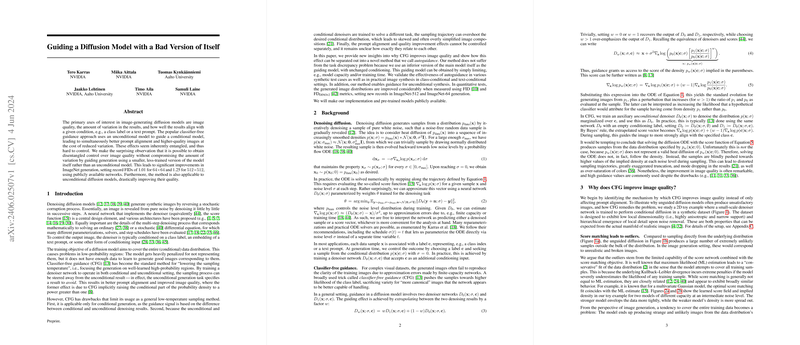Analysis of the Paper: "Guiding a Diffusion Model with a Bad Version of Itself"
The paper authored by Tero Karras et al., titled "Guiding a Diffusion Model with a Bad Version of Itself," investigates the use of an inferior variant of a diffusion model to enhance the quality of generated images. The primary areas of interest for evaluating image-generating diffusion models are image fidelity, variation in results, and alignment with the conditioning input, such as a class label or text prompt. The authors propose a novel guidance technique termed "autoguidance," which leverages a degraded version of the model itself, as opposed to the traditional classifier-free guidance (CFG).
Diffusion Model and Classifier-Free Guidance
Denoising diffusion models, which generate images by reversing stochastic corruption processes, are central to this paper. These models use neural networks for denoising (or approximating the score function) and employ various architectures and denoising processes parameterized by different solvers and schedules.
Classifier-free guidance (CFG), the current standard for improving image quality in this context, utilizes an unconditional model to guide a conditional model. This steering results in better prompt alignment and higher quality images but often reduces output diversity. The authors observe that CFG inherently entangles image quality improvement with prompt alignment and presents a challenge in controlling these effects separately.
Autoguidance: Methodology and Insights
The primary contribution of this paper is the autoguidance method, which replaces the unconditional model in CFG with a smaller, less-trained version of the conditional model itself. This innovation aims to provide disentangled control over image quality without compromising result variation.
Synthetic Dataset Experiment
A key experiment involves a 2-dimensional synthetically created dataset designed to resemble the complex data distributions of real-world image datasets. The experiment demonstrates compellingly that traditional CFG can oversimplify the sample distribution, leading to a reduction in diversity and unnatural concentration in high-probability regions. In contrast, autoguidance directs samples away from low-probability areas while maintaining diversity.
Numerical Results and Empirical Evidence
- ImageNet-512 and ImageNet-64 Performance:
- The application of autoguidance to the EDM2 model on these datasets presented significant performance improvements. Specifically, FID scores improved to 1.25 for ImageNet-512 and 1.01 for ImageNet-64, setting new records for these models.
- Unconditional Model Improvement:
- Addressing a known issue where unconditional models perform poorly compared to their conditional counterparts, autoguidance drastically improved their results, demonstrating reduced FID from 14.79 to as low as 8.42.
These results illustrate that autoguidance can significantly enhance the quality and realism of images generated by diffusion models across various settings.
Theoretical and Practical Implications
From a practical standpoint, autoguidance can be easily integrated with existing models to yield better results without altering the fundamental architecture or training paradigm. This adaptability is particularly advantageous for large-scale models where retraining could be computationally prohibitive.
Theoretically, the paper invites further exploration into understanding the specific conditions under which autoguidance provides optimal results. It introduces a new line of inquiry concerning the relationship between model capacity, training duration, and the type of degradation used for the guiding model.
Future Developments in AI and Diffusion Models
Looking forward, the autoguidance approach may inspire new methods for guiding diffusion models, potentially involving more sophisticated degradation techniques or hybrid models incorporating both synthetic and real-world data degradations. Additionally, the implications of autoguidance for other types of generative tasks, such as text or audio generation, present promising avenues for research.
Conclusion
The paper by Karras et al. provides a substantial advance in the theory and application of diffusion models for image generation. By employing a strategically degraded version of the model itself for guidance, they achieve better image quality and maintain diversity in outputs, setting new benchmarks in the field. This technique broadens the horizon for future innovations and applications, paving the way for more refined and efficient generative models.
